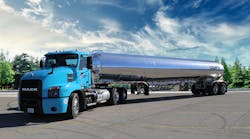TAKE it from Tom Kloza, the global head of energy analysis for the Oil Price Information Service (OPIS): Bombshell Spanish actress/model Penelope Cruz isn’t going to ask him out on a date.
What does this have to do with oil prices? A lot. Well, at least a little.
“$43, $44, $45 a barrel, we may be around this number for a while,” he said. “Don’t trust when people say we’re going to be $65, $70, $75, $80 by the end of the year. It’s possible, but possible in the same sense that Penelope Cruz might call me up and say, ‘Come over for some espresso.’ ”
In his presentation, “2016 Oil Outlook: When Do the Head Fakes End?” Kloza told those attending the National Tank Truck Carriers 68th Annual Conference April 24-26 in San Diego, California, that the old oil era is gone.
“The days of $140 and $150 a barrel are over,” he said. “Unless we have a worldwide confrontation where we have greater problems than oil, the days of $110 oil are beyond us. But if you listen to everyone on TV, there is a misimpression of what that means for this country. It’s actually mostly good news for this country.”
Asking if there are really any global energy price experts, Kloza presented these statements:
• September 22, 2014, Jim Volker, chief executive officer of Whiting Petroleum: “Let’s not panic over the first little decline in oil prices.”
• November 5, 2014, T Boone Pickens, chairman & CEO of BP Capital: “This has only been going on for 30 days. The world hasn’t changed. OPEC (the Organization of Petroleum Exporting Countries) has got to have a better price for oil than $80 a barrel.”
• November 10, 2014, John Hess, CEO of Hess Corp: “We have an $80 Brent case; that is what we call our stress test. We don’t think $80 Brent is likely.”
• November 26, 2014, Kloza, via CNBC: “Oil could plummet to $35 a barrel in 2015 if OPEC doesn’t reach an agreement by the spring.”
• January 1, 2015, Andy Hall, crude trader and commodities hedge fund manager, proclaimed that $40 a barrel represented an “absolute price floor,” saying that crude couldn’t sell for long below the marginal cost of supply.
• April 7, 2015, Kloza, via CNBC, after crude prices went back to $62: “Don’t trust this oil bounce.”
He said that a year ago, 2016 projections were anywhere from $57 to $65 per barrel.
“We’re nowhere near that,” he said. “I’d submit to you we’re not going to get to any of those predicted numbers through the rest of this year. There’s a chance of it toward the end of the year, but everything has to go well.”
He said international data integrity is sketchy, citing the BP oil spill as an example of the “Energy Data Schvitz.”
“In April 2010, we had the oil spill,” he said. “First, it was 50,000 barrels a day, then 60,000 a day. To this day, we have no idea how much oil leaked into the Gulf of Mexico. Scientists have had time to study it and can’t even give a number.
“There is one sacred truth: size does matter. As recently as 1995, the total open interest across NYMEX (now operated by the Chicago Mercantile Exchange) and the Intercontinental Exchange (which took over the IPE) was less than one million contracts, or about one billion barrels. More recently, there is participation that easily exceeds six million contracts, or six billion barrels in the cornerstone energy contracts (Brent, WTI, Gasoil, ULSD, and RBOB). This doesn’t even take into account many of the derivatives that trade off exchange, or on the CME Clearport platform and it completely ignores any volumes of futures trading on the NASDAQ.
“People think the supply has been about 96 or 97 million barrels a day and demand has been about 94 or 95. We’re not measuring these things with precision. It’s a little bit like getting your hair cut with a chainsaw. So the scope of the market is amazing.”
Some other predictions:
• Crude oil prices will remain under pressure as long as the Middle East troika maintains market share strategy. Shale costs are extremely variable, but expenses are dropping.
• A return to $70 a barrel for crude would bring 10 million barrels per day or more of US crude oil output.
• The seasonality of gasoline will continue as time goes on.
There are fundamental reasons why the market is bipolar. Oil shale is now the marginal barrel. Easy access to crude oil and descending costs mean that $80 per barrel is the ceiling, as opposed to the 2011-2014 floor.
Asking if diesel has lost its mojo, Kloza wondered if it’s “no longer the magic molecule.”
“Refiners have tilted construction and infrastructure toward making more diesel,” he said. “There’s no going back on that trend. Gasoline is the marquis product for refiners; diesel is a huge, but low volume, money-maker for marketers. This may be the start of a new normal. Worldwide gas demand is on the rise; diesel demand gets crimped by still sluggish shale and weakness in commodity countries.
“New refining capacity is still coming on internationally as well as the United States. The yields are tilted toward diesel and jet fuel. Still, diesel inventories in all states is very much ‘just in time.’ AG-related rallies are certain, as are Polar Vortex rallies.”
His observations on US refining trends:
• Refineries are much more valuable assets these days, and are sophisticated. That means the maintenance cycles are longer, and breakdowns during periods of high runs occur more often.
• Another 200,000 b/d of US refining capacity comes online in 2016, so by year’s end we’ll have added two million b/d of capacity in the 21st Century. Most of the additions are tilted toward diesel (Montana, North Dakota).
• Worldwide additions to diesel and jet fuel production have been too ambitious, particularly given slowdowns in emerging market countries.
• Gasoline is now the marquee product, or the make-or-break product. Diesel had that stature from 2007-2015.
• We won’t need to host telethons or ice bucket challenges for refiners.
The key drivers of oil price volatility in the next 20 months: outright crude oil prices; variable gasoline recipes; export and import dynamics; financial fund flows; ETFs; daily trading of annual volume; and just-in-time, a key North American metric.
“Shallow product inventories are quick to fill, but also quick to empty,” he said. “Storage per capita is a mere fraction of what it was in 1975-1985. Just-in-time reigns supreme for gasoline seasonal, but diesel seasonal is very much weather-dependent.”
Some final random observations from Kloza:
• “The first instances where WTI crude settled above $40 barrel came on October 9 and October 11, 1990. Not until May 11, 2004, did WTI again settle above $40 barrel. If you are keeping score, that was a span of 4,961 days.”
• “Top executives from Shell and BP have both recognized global warming, and have indicated that the world needs to more aggressively cut back on fossil fuel consumption. California, then Oregon and Washington?”
• “The planet will have many more cars in the next five years. Automobile penetration rates in developed countries run around 54%, versus about 14% in emerging countries. If China matched the developed rate, it would require the sale of another 580 million vehicles there.”
• “Oil producers lack flexibility and finesse and with the exception of the years where the OPEC cartel has real clout, they have little choice but to continue pumping. Oil refineries do not face the same Hobson’s Choice. Hence, they can cut runs.” ♦











